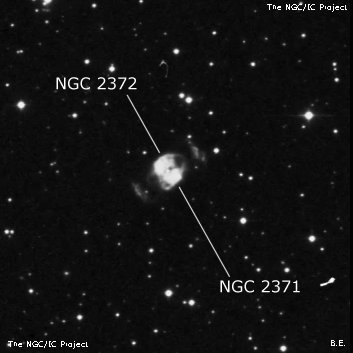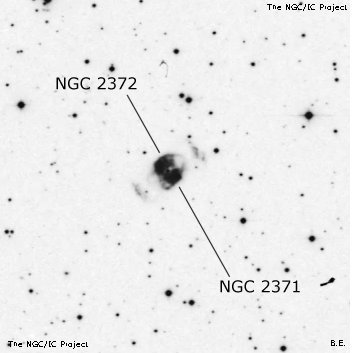NGC/IC Project Restoration Effort
(This is a very very beta version)
NGC2371


Basic Information
Location and Magnitude
Right Ascension: 7:25:33.9
Declination: +29:29:18
Constellation: GEM
Visual Magnitude: 11.2
Historic Information
Discoverer: Herschel W.
Year of discovery: 1785
Discovery aperture: 18.7
Observational
Summary description: B, S, R, bMN, p of D neb
Sub-type: PN
Steve's Notes
=====
NGC 2371
48" (4/1/11): I was stunned by the view of this bipolar nebula. There was so much intricate detail in NGC 2371/72 it had little resemblance to previous views through my 17.5" and 18" scopes. The most prominent feature was two, irregularly round, very bright nodules on the southwest and northeast side of the boxy, elongated central region. Each nodule was distinctive and varied in surface brightness and shape with the southwest lobe brighter. Filamentary streamers or a "hairy tail" extended from the northeast node towards the northwest and similar wisps extended mainly southeast from the southwest node, creating a sense of rotation around the fairly bright central star. The interior and sides were filled with much fainter nebulosity. A very faint filament connected the main lobes on the northwest edge. Detached from the main 1' structure were two amazing outer wings, symmetrically hanging 1' NW and 1' SE from the central star. These wings or "polar caps" were easily visible without a filter at 488x and both extended ~40"x10" in a SW-NE orientation, increasing the total diameter of the planetary to 2'. A mag 13.5 star lies 1.5' NW and a mag 16 star is 50" NE of center.
17.5" (2/14/99): very unusual appearance at 380x with two bright knots oriented SW-NE about 30" between centers and 0.9' in total length. The southwest knot is 15"-20" in size, slightly elongated and the brighter of the two. The northeast condensation has a slightly lower surface brightness and appears ~20" in diameter. The faint mag 14.9 central star is symmetrically placed between the knots. Weaker nebulosity connects the two knots giving a "dogbone" appearance with a very faint rounder halo encasing the structure!
17.5" (2/13/88): unusual planetary, bright, moderately large, elongated SW-NE. Two bright knots are at both ends (with two NGC designations) although the SW end is brighter and concentrated.
13" (2/25/84): two condensations in halo. The WSW side is brighter and sharper.



